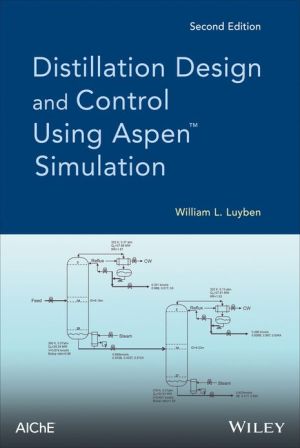

 |

|

Sold Out
Book Categories |
| Preface | xi | |
| 1 | Fundamentals of Vapor-Liquid Phase Equilibrium (VLE) | 1 |
| 1.1 | Vapor Pressure | 1 |
| 1.2 | Binary VLE Phase Diagrams | 3 |
| 1.3 | Physical Property Methods | 7 |
| 1.4 | Relative Volatility | 7 |
| 1.5 | Bubblepoint Calculations | 9 |
| 1.6 | Ternary Diagrams | 10 |
| 1.7 | VLE Nonideality | 12 |
| 1.8 | Residue Curves for Ternary Systems | 18 |
| 1.9 | Conclusion | 26 |
| 2 | Analysis of Distillation Columns | 27 |
| 2.1 | Design Degrees of Freedom | 27 |
| 2.2 | Binary McCabe-Thiele Method | 28 |
| 2.3 | Approximate Multicomponent Methods | 38 |
| 2.4 | Analysis of Ternary Systems Using DISTIL | 41 |
| 2.5 | Conclusion | 44 |
| 3 | Setting up a Steady-State Simulation | 45 |
| 3.1 | Configuring a New Simulation | 45 |
| 3.2 | Specifying Chemical Components and Physical Properties | 53 |
| 3.3 | Specifying Stream Properties | 58 |
| 3.4 | Specifying Equipment Parameters | 60 |
| 3.5 | Running the Simulation | 64 |
| 3.6 | Using "Design Spec/Vary" Function | 66 |
| 3.7 | Finding the Optimum Feed Tray and Minimum Conditions | 80 |
| 3.8 | Column Sizing | 81 |
| 3.9 | Conclusion | 84 |
| 4 | Distillation Economic Optimization | 85 |
| 4.1 | Heuristic Optimization | 85 |
| 4.2 | Economic Basis | 87 |
| 4.3 | Results | 89 |
| 4.4 | Operating Optimization | 91 |
| 4.5 | Conclusion | 97 |
| 5 | More Complex Distillation Systems | 98 |
| 5.1 | Methyl Acetate/Methanol/Water System | 98 |
| 5.2 | Ethanol Dehydration | 112 |
| 5.3 | Heat-Integrated Columns | 122 |
| 5.4 | Conclusion | 129 |
| 6 | Steady-State Calculations for Control Structure Selection | 130 |
| 6.1 | Summary of Methods | 131 |
| 6.2 | Binary Propane/Isobutane System | 133 |
| 6.3 | Ternary BTX System | 137 |
| 6.4 | Multicomponent Hydrocarbon System | 141 |
| 6.5 | Ternary Azeotropic System | 145 |
| 6.6 | Conclusion | 150 |
| 7 | Converting From Steady State to Dynamic Simulation | 151 |
| 7.1 | Equipment Sizing | 151 |
| 7.2 | Exporting to Aspen Dynamics | 153 |
| 7.3 | Opening the Dynamic Simulation in Aspen Dynamics | 156 |
| 7.4 | Installing Basic Controllers | 158 |
| 7.5 | Installing Temperature and Composition Controllers | 166 |
| 7.6 | Performance Evaluation | 179 |
| 7.7 | Comparison with Economic Optimum Design | 184 |
| 7.8 | Conclusion | 187 |
| 8 | Control of More Complex Columns | 188 |
| 8.1 | Methyl Acetate Column | 188 |
| 8.2 | Columns with Partial Condensers | 190 |
| 8.3 | Control of Heat-Integrated Distillation Columns | 209 |
| 8.4 | Control of Azeotropic Columns/Decanter System | 222 |
| 8.5 | Conclusion | 231 |
| 9 | Reactive Distillation | 232 |
| 9.1 | Introduction | 232 |
| 9.2 | Types of Reactive Distillation Systems | 234 |
| 9.3 | TAME Process Basics | 238 |
| 9.4 | TAME Reaction Kinetics and VLE | 241 |
| 9.5 | Plantwide Control Structure | 246 |
| 9.6 | Conclusion | 250 |
| 10 | Control of Sidestream Columns | 251 |
| 10.1 | Liquid Sidestream Column | 252 |
| 10.2 | Vapor Sidestream Column | 257 |
| 10.3 | Liquid Sidestream Column with Stripper | 264 |
| 10.4 | Vapor Sidestream Column with Rectifier | 271 |
| 10.5 | Sidestream Purge Column | 281 |
| 10.6 | Conclusion | 290 |
| 11 | Control of Petroleum Fractionators | 291 |
| 11.1 | Petroleum Fractions | 292 |
| 11.2 | Characterization of Crude Oil | 296 |
| 11.3 | Steady-State Design of PREFLASH Column | 304 |
| 11.4 | Control of PREFLASH Column | 311 |
| 11.5 | Steady-State Design of Pipestill | 316 |
| 11.6 | Control of Pipestill | 333 |
| 11.7 | Conclusion | 342 |
| Index | 343 |
Login|Complaints|Blog|Games|Digital Media|Souls|Obituary|Contact Us|FAQ
CAN'T FIND WHAT YOU'RE LOOKING FOR? CLICK HERE!!! X
 You must be logged in to add to WishlistX
 This item is in your Wish ListX
 This item is in your CollectionDistillation Design and Control Using Aspen Simulation
X
 This Item is in Your InventoryDistillation Design and Control Using Aspen Simulation
X
 You must be logged in to review the productsX
 X
 X

Add Distillation Design and Control Using Aspen Simulation, As the world continues to seek new sources of energy, the distillation process remains one of the most important separation methods in the chemical, petroleum, and energy industries. And as new renewable sources of energy and chemical feedstocks become mo, Distillation Design and Control Using Aspen Simulation to the inventory that you are selling on WonderClubX
 X

Add Distillation Design and Control Using Aspen Simulation, As the world continues to seek new sources of energy, the distillation process remains one of the most important separation methods in the chemical, petroleum, and energy industries. And as new renewable sources of energy and chemical feedstocks become mo, Distillation Design and Control Using Aspen Simulation to your collection on WonderClub |